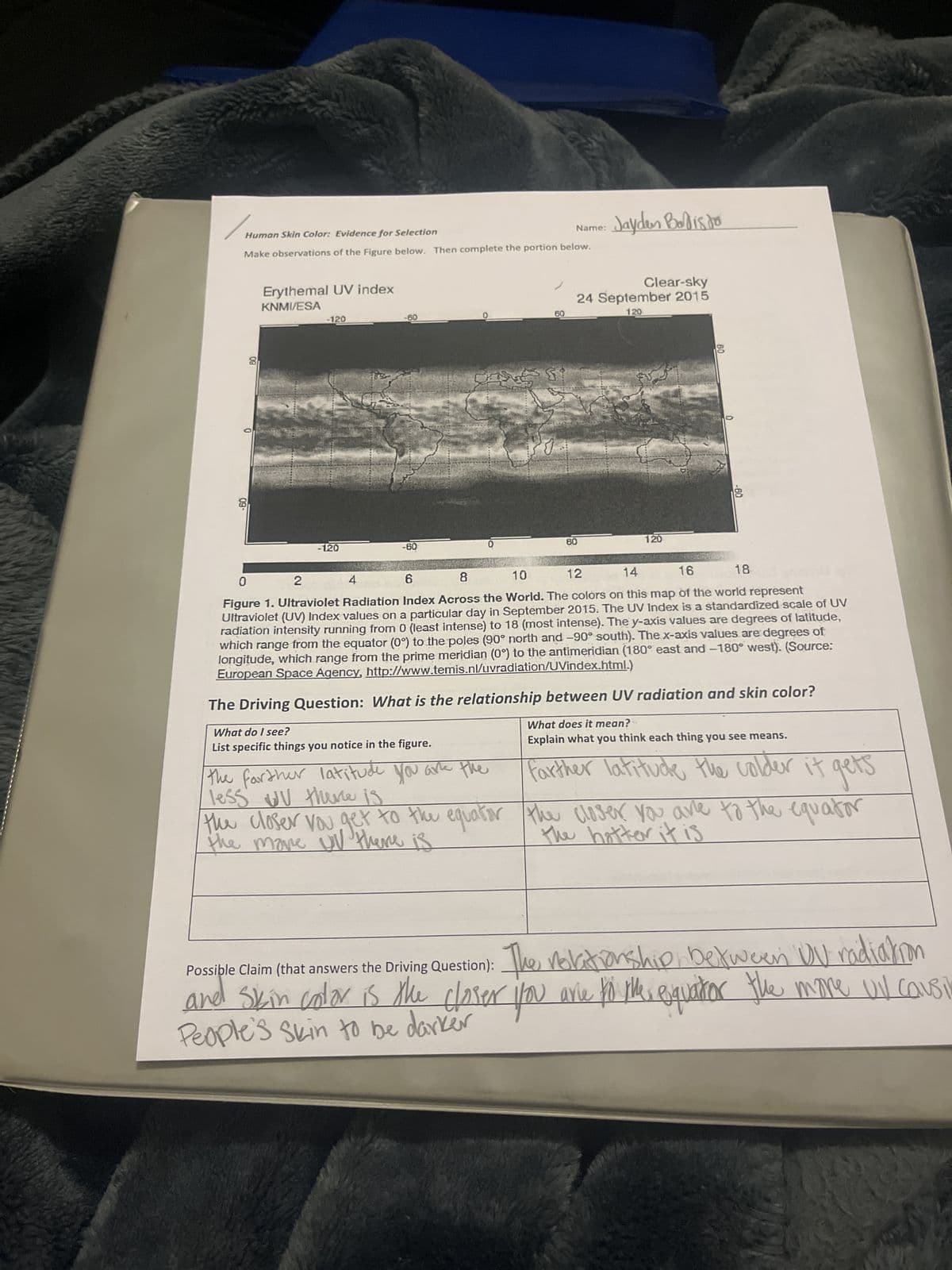Human Skin Color: Evidence for Selection Name: Jayden Bodisto Make observations of the Figure below. Then complete the portion below. Erythemal UV index 80 0 09- KNMI/ESA -120 0 -120 2 4 -60 6 8 10 60 Clear-sky 24 September 2015 120 10 60 12 14 120 16 -60 18 Figure 1. Ultraviolet Radiation Index Across the World. The colors on this map of the world represent Ultraviolet (UV) Index values on a particular day in September 2015. The UV Index is a standardized scale of UV radiation intensity running from 0 (least intense) to 18 (most intense). The y-axis values are degrees of latitude, which range from the equator (0°) to the poles (90° north and -90° south). The x-axis values are degrees of longitude, which range from the prime meridian (0°) to the antimeridian (180° east and -180° west). (Source: European Space Agency, http://www.temis.nl/uvradiation/UVindex.html.) The Driving Question: What is the relationship between UV radiation and skin color? What do I see? List specific things you notice in the figure. the farther latitude you are the less UV there is What does it mean? Explain what you think each thing you see means. farther latitude the colder it gets the closer you get to the equator the closer you are to the equator the move UV there is The hotter it is Possible Claim (that answers the Driving Question): The notationship between UV radiation to and Skin color is the closer you are for the equator the more uil causin People's Skin to be darker UV
Human Skin Color: Evidence for Selection Name: Jayden Bodisto Make observations of the Figure below. Then complete the portion below. Erythemal UV index 80 0 09- KNMI/ESA -120 0 -120 2 4 -60 6 8 10 60 Clear-sky 24 September 2015 120 10 60 12 14 120 16 -60 18 Figure 1. Ultraviolet Radiation Index Across the World. The colors on this map of the world represent Ultraviolet (UV) Index values on a particular day in September 2015. The UV Index is a standardized scale of UV radiation intensity running from 0 (least intense) to 18 (most intense). The y-axis values are degrees of latitude, which range from the equator (0°) to the poles (90° north and -90° south). The x-axis values are degrees of longitude, which range from the prime meridian (0°) to the antimeridian (180° east and -180° west). (Source: European Space Agency, http://www.temis.nl/uvradiation/UVindex.html.) The Driving Question: What is the relationship between UV radiation and skin color? What do I see? List specific things you notice in the figure. the farther latitude you are the less UV there is What does it mean? Explain what you think each thing you see means. farther latitude the colder it gets the closer you get to the equator the closer you are to the equator the move UV there is The hotter it is Possible Claim (that answers the Driving Question): The notationship between UV radiation to and Skin color is the closer you are for the equator the more uil causin People's Skin to be darker UV
Chapter2: Safety In Phlebotomy
Section: Chapter Questions
Problem 1.4E
Related questions
Question

Transcribed Image Text:Human Skin Color: Evidence for Selection
Name:
Jayden Bodisto
Make observations of the Figure below. Then complete the portion below.
Erythemal UV index
80
0
09-
KNMI/ESA
-120
0
-120
2
4
-60
6
8
10
60
Clear-sky
24 September 2015
120
10
60
12
14
120
16
-60
18
Figure 1. Ultraviolet Radiation Index Across the World. The colors on this map of the world represent
Ultraviolet (UV) Index values on a particular day in September 2015. The UV Index is a standardized scale of UV
radiation intensity running from 0 (least intense) to 18 (most intense). The y-axis values are degrees of latitude,
which range from the equator (0°) to the poles (90° north and -90° south). The x-axis values are degrees of
longitude, which range from the prime meridian (0°) to the antimeridian (180° east and -180° west). (Source:
European Space Agency, http://www.temis.nl/uvradiation/UVindex.html.)
The Driving Question: What is the relationship between UV radiation and skin color?
What do I see?
List specific things you notice in the figure.
the farther latitude you are the
less UV there is
What does it mean?
Explain what you think each thing you see means.
farther latitude the colder it gets
the closer you get to the equator the closer you are to the equator
the move UV there is
The hotter it is
Possible Claim (that answers the Driving Question): The notationship between UV radiation
to
and Skin color is the closer you are for the equator the more uil causin
People's Skin to be darker
UV
AI-Generated Solution
Unlock instant AI solutions
Tap the button
to generate a solution
Recommended textbooks for you



